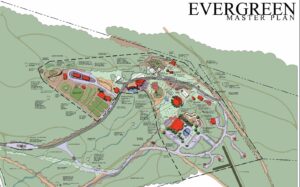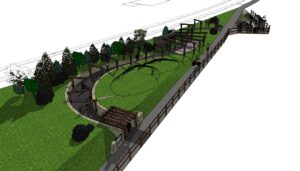So you want to become a Landscape Architect?
Written by: Corey Armstrong

Corey Armstrong started in the landscape industry as a teenager working for a friend and fellow classmate doing odd-jobs, planting shrubs and mulching. Later, summer mornings before his senior year in high school evolved into riding in the front passenger seat of an old pickup truck while sketching on Dunkin Donut napkins, this experience serving both as initial design studio time and unofficial construction documentation for much larger backyard renovations, poolscapes, and elaborate planting layouts in local suburban neighborhoods. This modest introduction to design/build would lead Corey to completing his BS in Landscape Architecture from West Virginia University, working in multi-disciplinary firms outside of New York City, becoming a licensed landscape architect, and utilizing powerful 3-D renderings and designs to manage millions of dollars in design-build construction over the years. Corey has been fortunate to work on many creative and rewarding employment opportunities in the landscape architecture profession and joined the Triad team in early January 2024.
What in the world is a Landscape Architect?
If you don’t already know, Landscape Architects are the ethereal gatekeepers to experiential and aesthetic enlightenment. They are the manifest’ers of brilliant physical splendor where they and Mother Nature herself tango in the twilight, coalescing their opulent wisdom to draft the blueprints so that common man can build places we adore, destinations we discover, majestic gardens we walk and admire, and the homes, castles, and kingdoms we make our own.
Alright. That might be a little much. Let me start over.
Landscape Architects (LA’s) are trained professionals who design outdoor spaces, drawing from a blend of integrative and academic training, collaborative studio projects, drafting experience, a vast knowledge of plant and construction materials and methods, and real-world immersion. But getting your degree is only the first step. A Landscape Architect must bring sharp attention to detail to every project. Strong client involvement and comprehensive site assessments generally evolve into a host of tasks, including preparing contracts, conducting site surveys, analyzing environmental reports, and working together with diverse stakeholders. LA’s utilize CAD and other software to create detailed plans and renderings, and success in this role hinges on staying updated with industry trends, conducting interdisciplinary research, and effectively communicating with clients and team members. An invested approach and passion for the profession will often lead to working on some very cool projects in the design, development, and construction industries.
Allow me to go in a little more detail…
Often the case, Landscape Architects have a creative magnetism to reckon with. They like graphics and have an eye-for-design. They like building things too; they are the kids who played in the dirt, dragged logs through the woods to construct forts – then campfires, jumped in streams after crayfish and salamanders, stacked rocks, and doodled in class. As professionals, landscape architects employ various levels of site design, civil engineering, and architecture to improve and add interest to the built environment.
They are inherently self-motivated to create places they themselves would love to interact in.
Landscape Architects are proficient in showcasing, enhancing, or mimicking natural landscapes, elements, and systems. They design and manage projects ranging from regional park systems that span hundreds of thousands of acres, or major urban redevelopment initiatives, to quaint patio spaces in residential applications. LA’s are trained to design and manage everything from stormwater in parking lots, or pedestrian and bike trail systems, to dreaming up recreational destinations like luxury golf courses, and crafting unique experiences found in interactive zoos, resorts, or in extravagant coastal wedding venues.
Landscape architecture is a vocation that aims to improve the relationship and interactions between people and a specific environment.
So what?
Well, if you want to enrich the connection within, or to a particular place, you might consider hiring a landscape architect. Depending on the project, LA’s can work solo, working one-on-one with an individual client or organization from start to finish. On bigger projects, LA’s typically collaborate with a team of engineers (civil, structural, transportation, etc.), architects, and/or an endless list of site-specific experts and stakeholders. Like most design consultants, LA’s are often responsible for providing solutions to complex and multifaceted projects. Managing budgets, directing communication efforts with and between various shareholders, designing sites with ever-changing zoning and building criteria, and in diverse urban and natural environments, or meeting aggressive timelines while leading a team of consultants and contractors are all part of an LA’s daily considerations.
Landscape Architects are called upon for other specific, niche, and custom projects too. Some projects aim to revitalize sites with historical and cultural significance, or to memorialize places, events or individuals in a given area. LA’s are often fortunate to find themselves in meaningful, professional design endeavors, and sometimes, we get to work in our very own communities!
Here’s a couple of unique projects I have worked on as a registered landscape architect.
Evergreen Heritage Center Foundation (EHC)– Mt. Savage, Maryland
Nestled in Western Maryland’s Appalachian Mountains, the EHC, or Evergreen, is now a 130-acre historically rich and natural environment settled by Edward Grimes, a Lieutenant in the Revolutionary War. Teeming with boulders, native flora and abundant wildlife, a working farm and mature forest, fifth generation family member and founder Janice Keene created a landmark non-profit organization and award-winning environmental education center. Evergreen currently hosts thousands of students annually in the tri-county elementary, middle, high schools, and local colleges, not to mention regular tours from countless organizations, recreational enthusiasts, legislators, and community supporters.
The site boasts ruins of a rich mining era, including an old schoolhouse foundation, mule trails that once connected to an existing railroad line, an old house with a freshwater spring that runs through the cellar, and an immaculately preserved chestnut oak barn on the national historic registry (now a popular wedding venue), built in 1780.
Mrs. Keene needed a comprehensive plan to guide, to grow, and to increase exposure, support, and success of her foundation. Numerous historical elements had to be renovated or revitalized, and increased visitation demanded new opportunities, low impact parking, vehicular, pedestrian and mountain bike circulation, and wayfinding. The land is environmentally sensitive with protected species and habitat, creeks, and natural springs which present both limitations and opportunity. With much of the land off-grid, specialized and non-conspicuously applied solar applications were introduced to power the growing facility without negotiating historic relevance, building materials or site features.

I try to visit a couple times a year, and Mrs. Keene has told me on many occasions that the plan has enabled her to be awarded hundreds of thousands of federal and state dollars to maintain, create and expand opportunities that support the goals of her non-profit. The project drawings have been inserted in hundreds of presentations as well as in grant applications and other publications. As a landscape architect, thousands of people each year get to walk the trails, celebrate the views we created, to learn and discover, and experience the site in a way that commemorates the beauty of the past while looking positively to the future.
Coal Miner Memorial Project, Frostburg, Maryland
The Coal Miner Memorial Project is a special site that celebrates the rich history of coal mining in the community, specifically the many people who lost their lives in the mines over time. Located uphill of the popular Great Allegany Passage bike trail that connects Pittsburgh to Washington D.C, and adjacent to the scenic railroad and steam engine train depot, The Coal Miner project was born out of the interest of local historians and long-time residents that formed a small committee. They approached me with old black and white photographs of local miners, stories of tragedy, of honor and ‘hardscrabble’ resilience. They educated me with stories and tattered maps of deep mines whose remnants still intersect underground below Frostburg and in the surrounding hills. Everyone in this community, it seems, has a family member who worked in the mines and the connection was not lost on me. Before she passed away recently, my wife’s grandmother (both also from Frostburg) would tell me stories of her father and uncles who came from Germany to work in the mines. To hear these detailed and very personal stories is captivating – often tragic, and compelling to say the least.
The goal of the project was to envision a destination that would honor the miners, many of whom were children, and whose stories are mostly unknown to the general public. Without much design experience, the committee knew simply that they wanted to create a place where families could come and read the names and a brief biography of their relatives, and to commemorate their lives. As a landscape architect, I understood the significance of this project. I knew I needed to celebrate a grander history, sustain the pride of a small community, and authenticate a place for genuine reflection. The design was intended to reproduce an experience, to evoke imagination, and to educate those that visit who may not have a connection to the region or to coal mining.

The 1-acre, triangle-shaped parcel happened to be on a somewhat limiting, sloping grade. By chance, the design took shape quickly, and the site lent itself to cutting into the hillside to create a pathway or simulated mine-shaft. Locally sawn timbers were specified overhead to replicate shaft supports, and large retaining walls on each side generate a sense of confinement. As you crest the slope and “come out of the mine,” you are met by a life-size bronze statue of a miner that captures your attention amid the backdrop of the Allegheny Mountains. Native plants and giant boulders flank the main walkway, and interpretive signs, photographs, and banners that list hundreds of the fallen miners surround you as you move throughout the site.
In Summary
Landscape Architects are trained to practice with a diverse skill set to create solutions and benefits for various kinds of sites, projects, and applications. Often passionate about their work – whether working alone or as part of a team, LA’s use creative, technical and practical approaches to enhance natural or constructed environments. In my (perhaps not-so-much) humble opinion, if you or your organization is thinking about meaningful space or place-making, large or small, meeting with a landscape architect is an awesome place to start!


